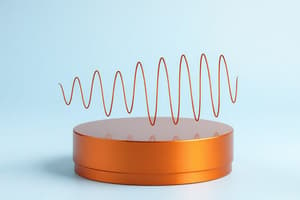Podcast
Questions and Answers
What does the period of a sinusoidal function refer to?
What does the period of a sinusoidal function refer to?
- The translation of the entire function along the y-axis
- The distance between equivalent points on consecutive cycles (correct)
- The shift of the entire function along the x-axis
- The proportional relationship between force and displacement
In a sine function, what is the value of the period in radians?
In a sine function, what is the value of the period in radians?
- $\frac{3}{2}\pi$
- $\frac{5}{2}\pi$
- $2\pi$ (correct)
- $3\pi$
Which term in the standard notation $y = A\sin(B(x - C)) + D$ represents the vertical shift of the function?
Which term in the standard notation $y = A\sin(B(x - C)) + D$ represents the vertical shift of the function?
- $C$
- $D$ (correct)
- $A$
- $B$
What is the primary application of sinusoidal functions in signal processing?
What is the primary application of sinusoidal functions in signal processing?
Which field heavily utilizes sinusoidal functions to model real-world phenomena with periodic behavior?
Which field heavily utilizes sinusoidal functions to model real-world phenomena with periodic behavior?
How does Fourier analysis contribute to signal processing?
How does Fourier analysis contribute to signal processing?
What is the period of the sine function $y = \sin(x)$?
What is the period of the sine function $y = \sin(x)$?
Which of the following represents the amplitude of the function $y = 3\cos(2x - \pi/4) + 2$?
Which of the following represents the amplitude of the function $y = 3\cos(2x - \pi/4) + 2$?
If $y = A\sin(B(x - C)) + D$, what does the constant $C$ represent?
If $y = A\sin(B(x - C)) + D$, what does the constant $C$ represent?
What is the value of $\cos(\pi/2)$?
What is the value of $\cos(\pi/2)$?
If $y = 2\sin(x - \pi/3)$, what is the phase shift of the function?
If $y = 2\sin(x - \pi/3)$, what is the phase shift of the function?
Which of the following functions is a sinusoidal function?
Which of the following functions is a sinusoidal function?
Study Notes
Sinusoidal Functions
Sinusoidal functions, particularly those involving the sine and cosine functions, are fundamental to mathematics and physics. They are used to describe periodic phenomena, such as sound and light waves, and are the basis for many applications in engineering, physics, and other fields. In this article, we will discuss the basics of sinusoidal functions, their properties, and how they are used to model periodic phenomena.
Understanding Sinusoidal Functions
A sinusoidal function is a periodic function that smoothly oscillates between high and low values. The most basic sinusoidal function is the sine function, which can be represented mathematically as (y = \sin(x)). This function oscillates between -1 and 1, with a period of (2\pi) radians (or (360) degrees).
The cosine function is another type of sinusoidal function, which can be thought of as a phase shift of the sine function by (-\pi/2) radians. It is represented mathematically as (y = \cos(x)). Both the sine and cosine functions are (2\pi)-periodic and oscillate between -1 and 1.
Properties of Sinusoidal Functions
-
Amplitude: The amplitude of a sinusoidal function determines the range of the function and is given by the absolute value of the coefficient before the sine or cosine function. For example, in (y = A\sin(B(x - C)) + D), the amplitude is represented by the coefficient (A).
-
Period: The period of a sinusoidal function is the distance between equivalent points on consecutive cycles. For sine and cosine functions, the period is (2\pi) radians ((360) degrees).
-
Phase Shift: Phase shift refers to the shift of the entire function along the x-axis without changing its shape. In the standard notation (y = A\sin(B(x - C)) + D), (C) represents the horizontal shift, also known as the phase shift.
-
Vertical Shift: Vertical shift, denoted by (D), represents the translation of the entire function along the y-axis.
Applications of Sinusoidal Functions
Sinusoidal functions are widely used due to their ability to represent periodic phenomena accurately. They are essential tools in many fields, such as physics, engineering, and signal processing. Some common applications include:
-
Modeling Periodic Phenomena: Sinusoidal functions are often used to model real-world phenomena that exhibit periodic behavior, such as the vibrations of a guitar string or the electromagnetic waves emitted by an antenna.
-
Signal Processing: In communication systems, signals are frequently analyzed using sinusoidal functions. Fourier analysis, for instance, breaks complex signals into their constituent frequencies, making it easier to understand and manipulate them.
-
Physics and Engineering: Many physical laws involve sinusoidal functions. For example, Hooke's law states that the force exerted on a spring is proportional to the amplitude of its displacement from equilibrium, which follows a sinusoidal pattern.
In conclusion, sinusoidal functions play a crucial role in mathematics and science. Their properties make them ideal for modeling periodic phenomena, and they have numerous practical applications in various fields. Understanding the basics of sinusoidal functions and their properties is essential for anyone interested in physics, engineering, or related disciplines.
Studying That Suits You
Use AI to generate personalized quizzes and flashcards to suit your learning preferences.
Description
Test your knowledge on sinusoidal functions, including the sine and cosine functions, their properties, and applications in mathematics, physics, and engineering. Explore concepts such as amplitude, period, phase shift, and vertical shift in sinusoidal functions.




